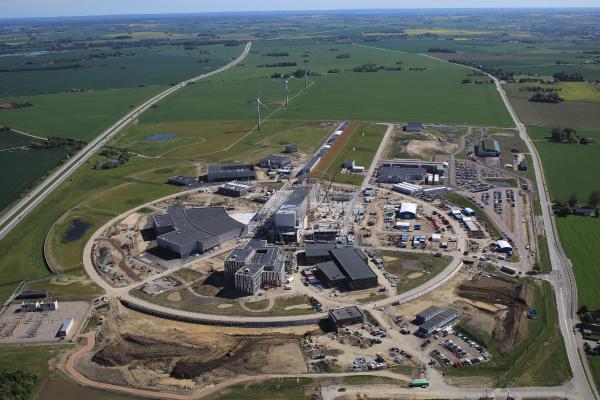
- European Investment Bank to extend tenor of original EUR 100 million credit facility signed in 2016.
- ESS obtains an additional tranche of financing worth EUR 50 million, supported under InnovFin, funded by the EU’s research and innovation programme Horizon 2020
The European Investment Bank has signed an increase of EUR 50 million (SEK 520 million) in the existing credit facility with the European Spallation Source (ESS) in Lund, Sweden. The loan was extended under the “InnovFin – EU Finance for Innovators” programme, with the financial backing of the European Union under Horizon 2020, the EU’s programme for research and innovation. On the same occasion, the parties also agreed to extend the tenor of the existing EUR 100 million credit facility, aligning it with the planned end of the construction phase of the project.
The ESS project originally marked the first time a project with an ERIC* statute was directly financed by the EU Bank. Apart from providing financing, the EIB’s InnovFin Advisory Service also provided technical advice to pave the way for the successful conclusion of the loan agreement.
“It’s quite an extraordinary project, which makes it all the more exciting for the EIB to support this." said Thomas Östros, EIB Vice-President. “Europe needs to continue investing in facilities like this one, which boost our knowledge and open scientific possibilities that we may not even have thought of yet. We have supported this project since its inception and are happy to continue our commitment to this landmark achievement of European scientific effort.”
Mariya Gabriel, European Commissioner for Innovation, Research, Culture, Education and Youth, said: “Big science facilities such as ESS push boundaries of human knowledge and improve people’s lives with advances in many fields, from health to building materials. That is why we have supported ESS since the beginning through grants and loans funded by Horizon 2020, the EU’s research and innovation programme. This second loan under the InnovFin instrument brings ESS one step closer to reality.”
ESS can be compared to a large “microscope”, as neutron scattering techniques offer the possibility to study material structures and motions at an atomic or molecular level. ESS will enable scientists to see and understand basic atomic structures and forces at length and time scales unachievable at other spallation sources. It thus opens new opportunities for researchers in multiple disciplines such as life science, environment, energy, transport and engineering, as well as physics, chemistry and even archaeology.
Background Information:
InnovFin - EU Finance for Innovators - Under Horizon 2020, the EU research and innovation programme for 2014-2020, the European Commission and the European Investment Bank Group (EIB and EIF) launched a new generation of financial instruments and advisory services in 2014 to help innovative firms access finance more easily. Until 2020, “InnovFin – EU Finance for Innovators” is offering a range of tailored products which provides financing in support of research and innovation by small, medium-sized and large companies and the promoters of research infrastructure.
InnovFin Large Projects aims to improve access to risk finance for research and innovation (R&I) projects emanating from larger firms; universities and public research organisations; R&I infrastructure (including innovation-enabling infrastructure); public-private partnerships; and special-purpose vehicles or projects (including those promoting first-of-a-kind, commercial-scale industrial demonstration projects). Loans and guarantees from EUR 25m to EUR 300m will be provided directly by the EIB.
The European Spallation Source (ESS) is a multi-disciplinary research centre based on the world's most powerful neutron source. ESS will give scientists new possibilities in a broad range of research, from life science to engineering materials, from heritage conservation to magnetism. ESS is a pan-European project, with Sweden and Denmark serving as host countries. The main research facility is currently under construction in Lund, Sweden, and the Data Management and Software Centre (DMSC) is located in Copenhagen, Denmark. ESS is expected to complete its construction in 2025. It is anticipated that 2.000-3.000 guest researchers from universities, institutes and industry will participate in the ESS user program each year, making use of the facility’s broad range of neutron instruments to answer their scientific questions.

